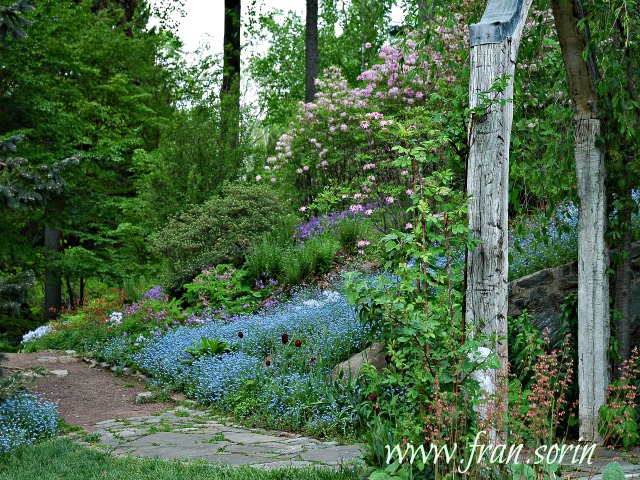Earlier this week I had the privilege of touring several of the gardens participating in this years Master Gardeners' tour.
The gardens have been chosen to showcase the variety of conditions we garden with in Austin; shady, sunny, rocky, sloping and flat. Some are planted with native and some with plants adapted to our growing conditions.
I garden in an area with rock and little soil so I am always amazed to enter a garden with such abundant foliage. Such was the case with the first garden I visited at 4603 Palisade Drive.
I was immediately struck by the hell strip planting. A mix of succulents and grasses.
The front garden slopes down towards the house and is heavily shaded. A perfect place to grow Berkeley sedge...
and a Japanese maple.
Around the back a huge palm presides over the pool area. Can you see the long dangling strings of seeds hanging from the palm. Maybe the result of a very wet May but I suggested to Sue that it might have something to do with competition from that bottle tree at its foot, with its string of twinkling lights. If you enjoy a lush green lush landscape then you will enjoy the setting of this garden with its towering trees. Some pleasing pieces of stone sculpture are the icing on the cake.
The next garden was in a neighborhood of small houses at 1315 Cullen Avenue. Once again a well planted hell strip with a purple martin house sure to distract the eye from the pole at the end of the street.
The surprise here was the double lot which, as you walked around, seemed to go on for ever. There is so much for the eye to take in that I felt the need to walk around the garden twice. In my head I called this the garden of many bird baths but I might just as well have called it the garden of many vegetable beds or useful repurposing.
Birds are made very welcome in this garden with a good supply of food and water.
The house has been remodeled and enlarged and the additional roof area made it worthwhile to install an impressive water collection system with 5000 gallon tank. Gardeners interested in installing a similar system would benefit from visiting this garden.
Also for ideas on container gardening and how to keep out the critters.
Here's a great idea. A pivoting gate for closing off an area when privacy is needed but allowing accessibility at other times.
The next garden on our tour I have visited many times from its early beginnings. I never tire of walking around this beautifully designed garden. It is the garden of Pam Penick, the nationally acclaimed author of the book Lawn Gone.
4503, Mountain Path Drive
Pam gardens almost exclusively with natives and is not afraid to experiment with design and planting. Of course in making her garden, getting rid of lawn was a priority. In the front she has used sedges and wooly stemodia to replace the area once planted with St Augustine grass. Because deer frequent she has had to bear that restriction in mind too.
Once a place where water collected during heavy rainfalls large stepping stones and gravel take care of heavy run-off. Recycled steel planted with yuccas and agaves add visual interest.
In the back garden a large stock tank takes center stage, the trickle of water from a recirculating stand pipe filling the air with that magically soothing sound.
Have you heard about Moby the whale's tongue agave? Whether you have or not you will just have to go and see him for yourself. He lords over the other side of the garden.
In need a a break after a long morning we stopped for lunch before heading out along Ranch Road 2244 to 1012 Weston Lane. The driveway leading up to the house has some impressive rock work on either side. We are away from the flat lots of in town and into the hillcountry.
There was little in the way of soil and in order to put in any plants a total of 14 truck loads of soil were brought in.
Drainage issues were solved by creating wet weather creeks which run across the front of the house and takes the water away to a safe place. A bronze duck is waiting for such a day.
I fear the visitors eye will be drawn immediately to the view at the back of the green sward. There is no doubt that the view, the stone work around the pool and the total setting is beyond words.
On a glorious day such as this I just wanted to plonk myself down on one of those chairs under the umbrella and drink it all in.
But do step back and admire the planting along the edge of the house. Because the house backs to the north this area is mostly in shade.
Regrettably I had to leave the tour at this point and missed the 3 remaining gardens. But you don't have to.
Information on the tour, including the addresses and map can be found at
Inside Austin Garden Tour.






























































































